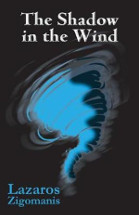The shadow in the wind by Lazaros Zigomanis

Pinion Press, 2019. ISBN: 9780648478904.
(Age: 10+) Recommended. Keene's mother has a strange illness, like a
darkness within her. She is confined to bed with a drip in her arm.
Keene can see shadows in the corner of her room, shadows that
threaten to envelop her. People keep saying that she might not get
better, but Keene is sure that if he could just find the special
citrine pendant that he had given her, that would help. The lady who
sold it to him had said that crystals help people feel better. But
the pendant was lost at Miller's Pond one weekend. Keene is sure
that he remembers where it is, but the problem is that nobody seems
to want to find it and he is not allowed to go into the bush alone.
Keene has to overcome many fears to venture into the bush. The trees
lean forward and grab at him; he can see scary faces in the tree
trunks, and voices call out to him. It is a dark and mysterious
world, like the world of a fairytale, with dangers lurking to trap
him. Will he be able to find the precious pendant, and bring it back
to his mother in time?
Zigomanis's story is about a young child ultimately coming to
understand that some things can't be fixed, that death may take
someone no matter how much you love them or try to save them. In his
writing Zigomanis evokes the imaginative world of the child: the
world of fairytales, of good and evil, of magic powers, where
ordeals must be overcome, to save the loved one, and have a happy
ending. For Keene, it is a terrible path to travel but in the end he
comes to a kind of acceptance, and finds ways to share his grief,
and commemorate the mother he loves.
It is a serious story, beautifully written; a semi-finalist in the
2017 Screencraft Cinematic Short Story Contest, and the adapted
screenplay a semi-finalist in the 2017 Screencraft Family-Friendly
Screenplay Contest. Despite being a relatively short story, there
are many themes that may be drawn out; teachers may refer to the
useful list of discussion questions at the end of the book.
Helen Eddy